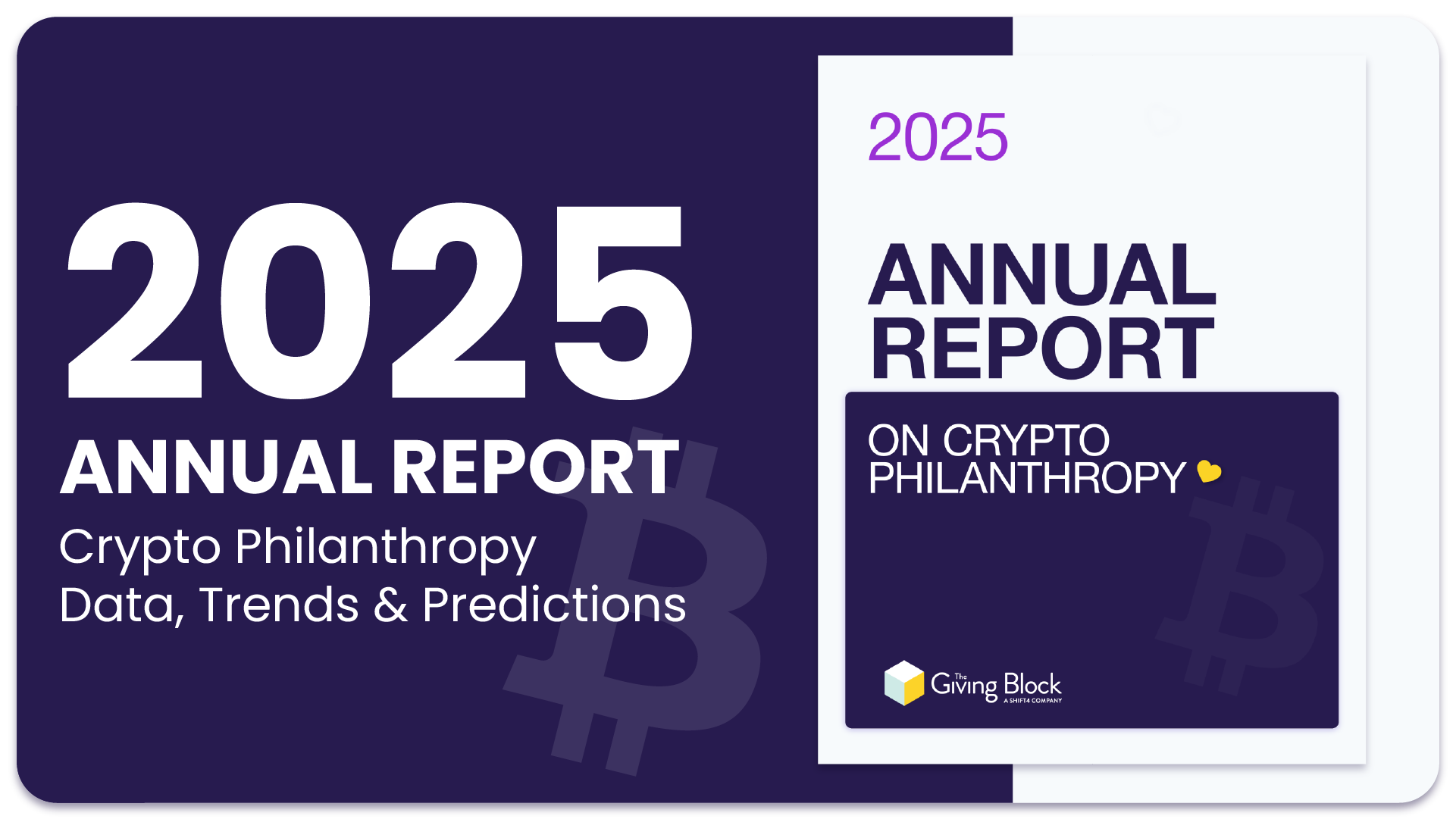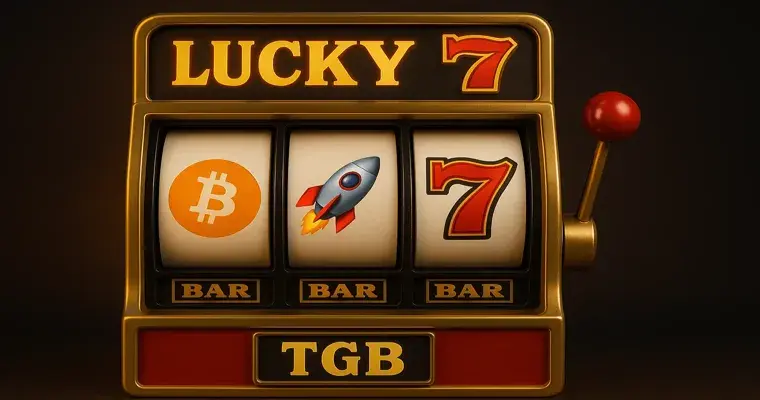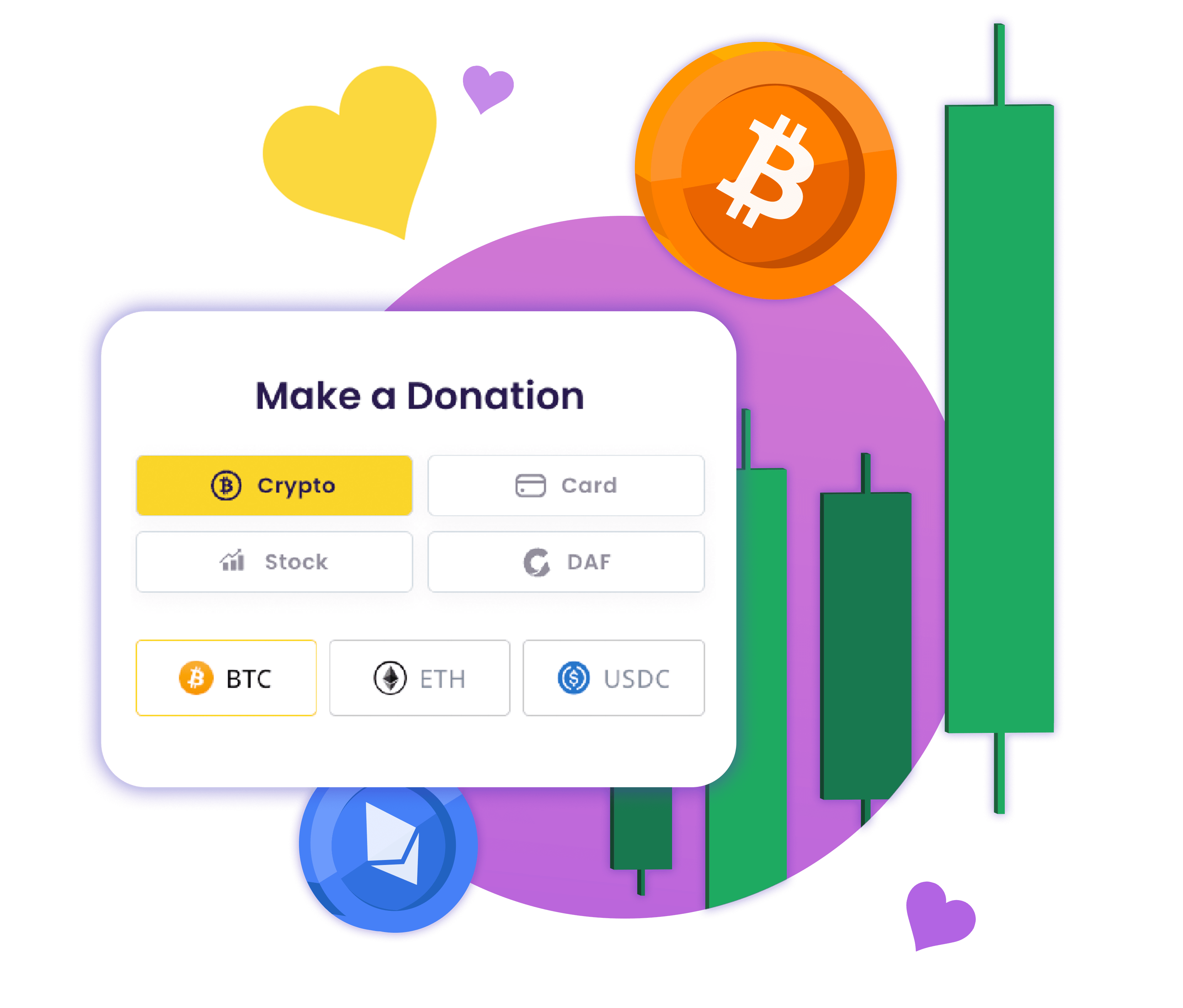Executive Summary
Founders Note
The world of philanthropy is undergoing a digital transformation, fueled by the rise of cryptocurrency. In the five years leading up to 2024, a staggering $2 billion in cryptocurrency had been donated globally, reported by Nonprofit Pro. This trend is being driven by both a surge in donor interest in crypto and a growing openness among nonprofits to accepting these digital assets.
In 2024 alone, it is estimated that over in crypto was donated to nonprofits.
Quietly, 2024 was by far the biggest year for crypto giving ever. Lost in the shuffle of the presidential election and the AI renaissance, cryptocurrencies boomed past previous all-time highs.
This growth in prices resulted in an explosion in giving, growing exponentially as the year wore on, with nearly one-third of cryptocurrency donations occurring in the last month of the year.
With the crypto market continuing to show strength, alongside a supportive political climate, we expect 2025 to blow 2024 out of the water, with parabolic growth of both the total number of nonprofits accepting crypto as well as the total cryptocurrency donated.
With cryptocurrency being the primary mode of investment for Gen Zs, and a Great Wealth Transfer beginning to move trillions of dollars into the hands of crypto investors, nonprofits are understandably bracing for the outsized role that crypto giving will play in philanthropy moving forward.
This report breaks down how our Crypto Philanthropy movement has gotten to where we are today, what factors drove the explosive growth of crypto giving in 2024, what nonprofits and their donors should expect (and strategize for) in 2025, and where we expect these trends to take us over the next decade.
If you’ve read this far, keep in mind that our team at The Giving Block helps nonprofits fundraise crypto, and we help crypto investors donate crypto to charities, universities, faith organizations and political groups. As you comb through our report, we hope you consider recommending our crypto acceptance solutions to your favorite charities, and our giving platform to the crypto enthusiasts among your friends and family.
Now, let’s dive in.
Pat Duffy & Alex Wilson
Co-Founders
Key Takeaways
For the World’s Top Nonprofits, Crypto is Now the Norm
- Crypto Philanthropy Growth: More than $1 billion in cryptocurrency has been donated to charitable causes in 2024 alone.
- Increasing Adoption: 70% of Forbes’ Top 100 Charities now accept cryptocurrency donations, marking a 25% increase from the previous year.
- Average Donation Size: The average crypto donation in 2024 was $10,978.28, which is a 386.33% increase from 2023.
The Growth of Crypto is Fueling Philanthropy
- Crypto Market Expansion: The total cryptocurrency market cap reached $3.72 trillion in 2024, surpassing the peak of the 2021 bull market and double the market cap of silver.
- Bitcoin All-Time High: Bitcoin peaked at $108,309 in December 2024, outperforming traditional financial assets like the S&P 500 .
- Stablecoin Transactions: Stablecoins processed nearly $30 trillion in transactions in 2024—more than Visa and Mastercard combined.
Crypto Will Transform Major Gifts Over the Next 10 Years
- Crypto Industry Market Cap: Analysts believe that the crypto market cap could reach up to $10 trillion in 2025.
- Total Giving Potential: Expect to see about $2.5 billion in crypto donated in 2025.
- Crypto Market Growth By 2035: The blockchain market is projected to grow to $776.47 billion by 2035, reflecting a compound annual growth rate (CAGR) of 42.98%.
- Crypto Donations By 2035: The Giving Block estimates crypto donations in 2035 would be approximately $89.27 billion.
Timeline: 15 Years of Crypto Philanthropy
What’s Inside: This section provides a high-level overview of the key events in the 15-year history of cryptocurrency, and its evolving role in philanthropy.
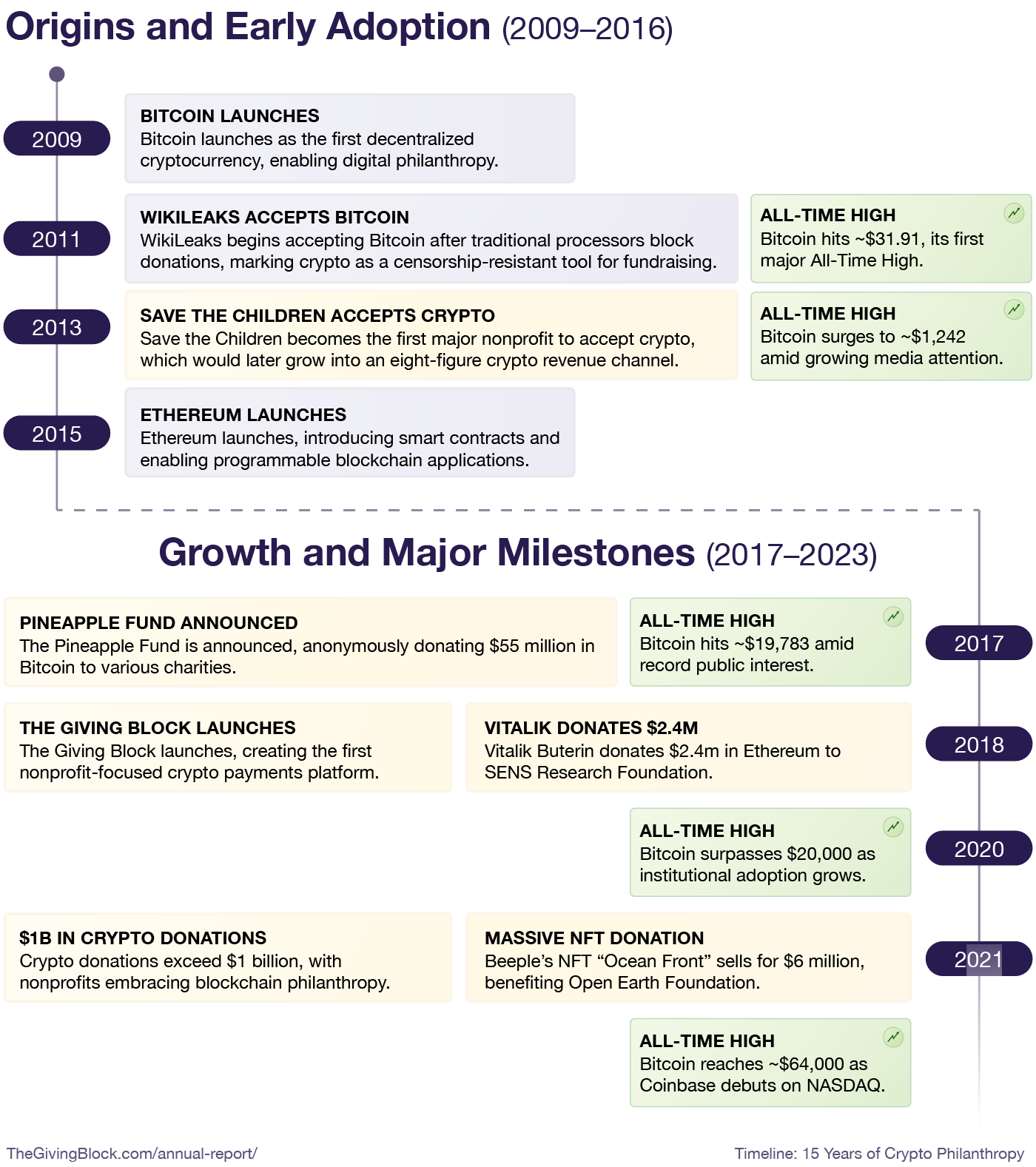
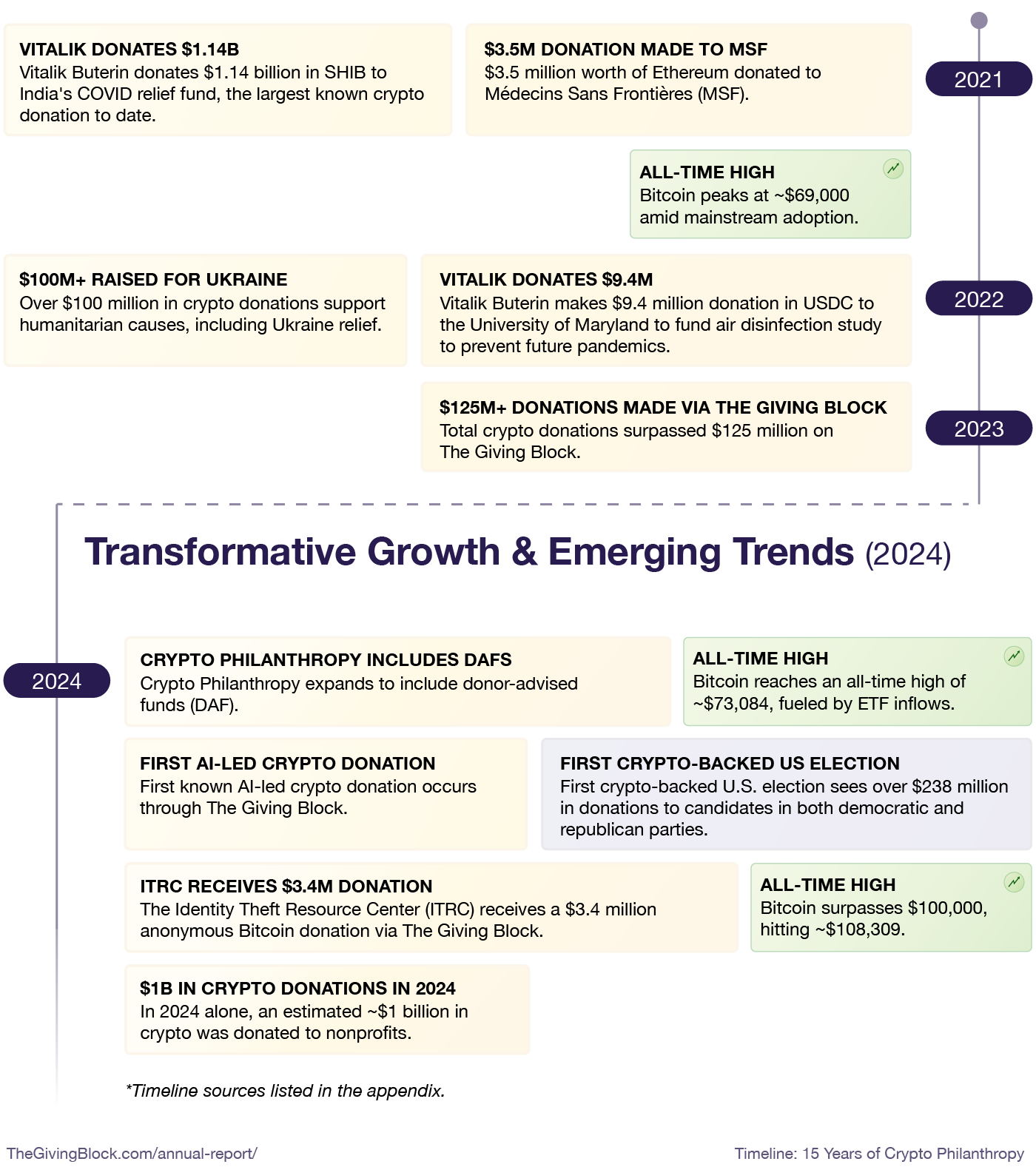
Key Takeaways in the Timeline of Crypto Philanthropy
Crypto Goes Mainstream, For Individuals and Institutions
Between 2018 and 2021, Crypto Philanthropy became mainstream. Platforms like The Giving Block facilitated access for nonprofits, while donations from high-profile individuals like Vitalik Buterin showcased the potential of crypto to impact philanthropy on a massive scale. The $1.14 billion SHIB donation in 2021 underscored the sector’s ability to mobilize unprecedented funds for global causes.
Crypto Goes Mainstream, For Individuals and Institutions
Between 2018 and 2021, Crypto Philanthropy became mainstream. Platforms like The Giving Block facilitated access for nonprofits, while donations from high-profile individuals like Vitalik Buterin showcased the potential of crypto to impact philanthropy on a massive scale. The $1.14 billion SHIB donation in 2021 underscored the sector’s ability to mobilize unprecedented funds for global causes.
Crypto Explodes in Rapid Response Fundraising
Crypto donations proved their value in responding to emergencies including global conflicts and natural disasters. For example, over $100 million in crypto donations supported Ukraine’s war relief in 2022, demonstrating how blockchain technology can expedite humanitarian aid.
AI and Crypto Are Colliding in Philanthropy
The first AI-led crypto donation in 2024 marks a new frontier. It demonstrates how artificial intelligence could facilitate, or even autonomously manage, philanthropic activities, expanding the possibilities of impact-driven blockchain applications.
2024 Report: Market Update & Crypto Giving Data
2024 Crypto Giving Data
What’s Inside: This section covers which cryptocurrencies were donated the most, how much giving happened and where it went. Key data points such as the average gift size, giving by cryptocurrency type, and quantified impact results are featured. We discuss the drivers behind growth as well as remaining challenges.
Total Crypto Donated
Crypto Philanthropy experienced a landmark year in 2024. Public reports from CNBC indicate that, as of November, hundreds of millions of dollars had been donated in cryptocurrency. Given additional undisclosed contributions, total crypto donations for the year likely exceeded $1 billion.
Nonprofits Accepting Crypto
More than 70% of the top 100 U.S. charities, as ranked by Forbes’ Top Charities List, now accept cryptocurrency donations. This shift underscores the growing adoption of crypto in the nonprofit sector. For major charities, faith-based organizations, and universities, fundraising through cryptocurrency has become the norm, reflecting a broader trend in modern philanthropy.
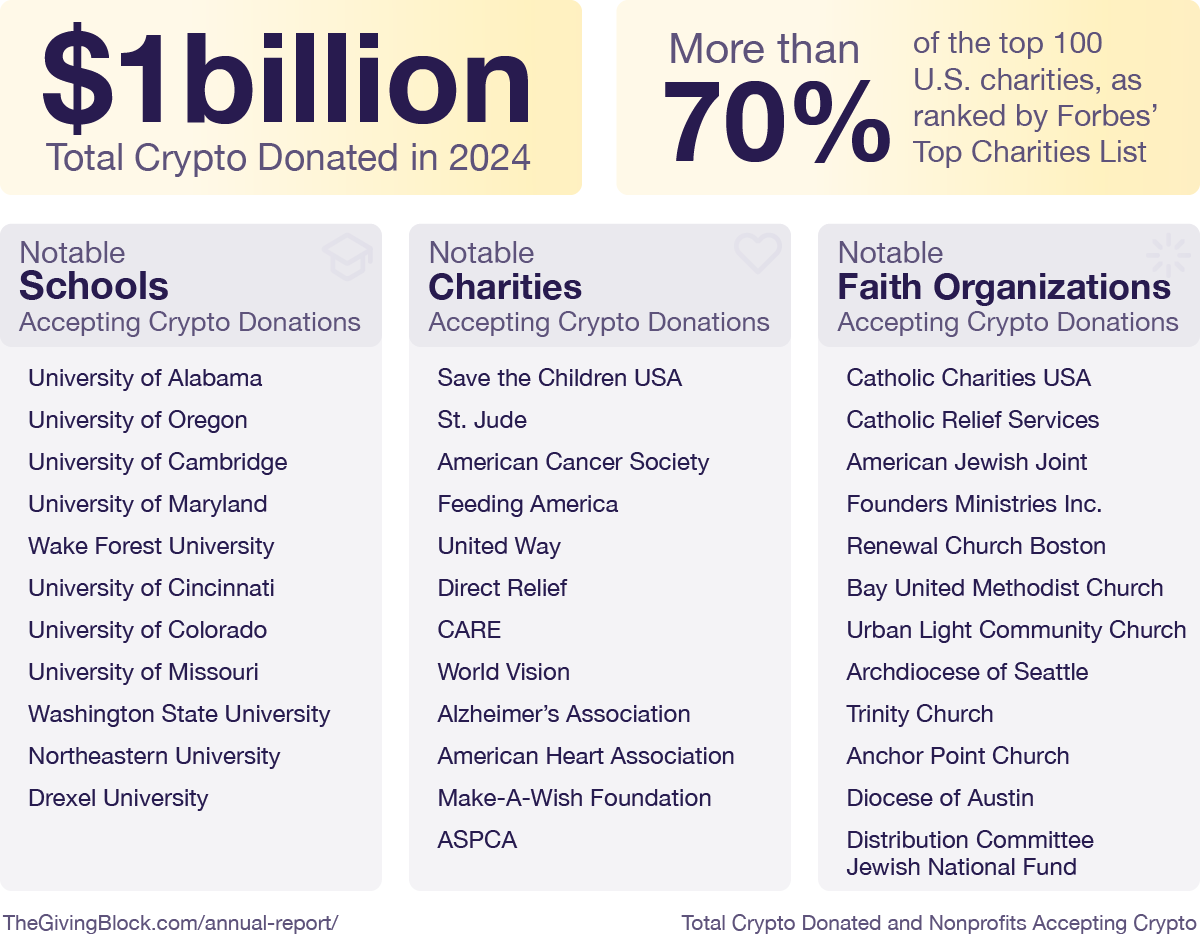
Access Full Report
Average Donation Size
The average donation size for crypto gifts in 2024 was $10,978.28.
Year-Over-Year Giving Growth in Crypto Philanthropy
Crypto giving saw explosive growth in 2024, increasing by 386.33% compared to 2023. This surge was driven by both a higher volume of donations and a substantial rise in the average crypto donation size, which grew from $2,257.36 in 2023 to $10,978.28 in 2024—a nearly fivefold increase. The data highlights a maturing crypto donor base, with individuals making larger contributions and embracing digital assets as a key vehicle for philanthropy.
- Year over Year crypto giving growth of 386.33% from 2023 to 2024
- 2023 Average Crypto Donation Size: $2,257.36
- 2024 Average Crypto Donation Size: $10,978.28
Most Donated Cryptocurrencies (Top 10)
In 2024, Bitcoin (BTC) was by far the most donated cryptocurrency, accounting for nearly twice as much giving as all other cryptocurrencies combined (64.3%).
In 2023, the data revealed a strong preference for stablecoins, with US Dollar Coin (USDC) accounting for 44% of all crypto donations. This trend is largely due to USDC’s price stability, as it is pegged to the U.S. dollar, making it an attractive option for donors seeking to minimize volatility. The demand for stablecoin donations tends to surge during periods of market downturns, such as the 2023 bear market when investors were reluctant to part with more volatile assets they perceived as undervalued. The second and third most donated cryptocurrencies of 2023 were Ethereum (ETH) at 24%, followed by Bitcoin at 17%.
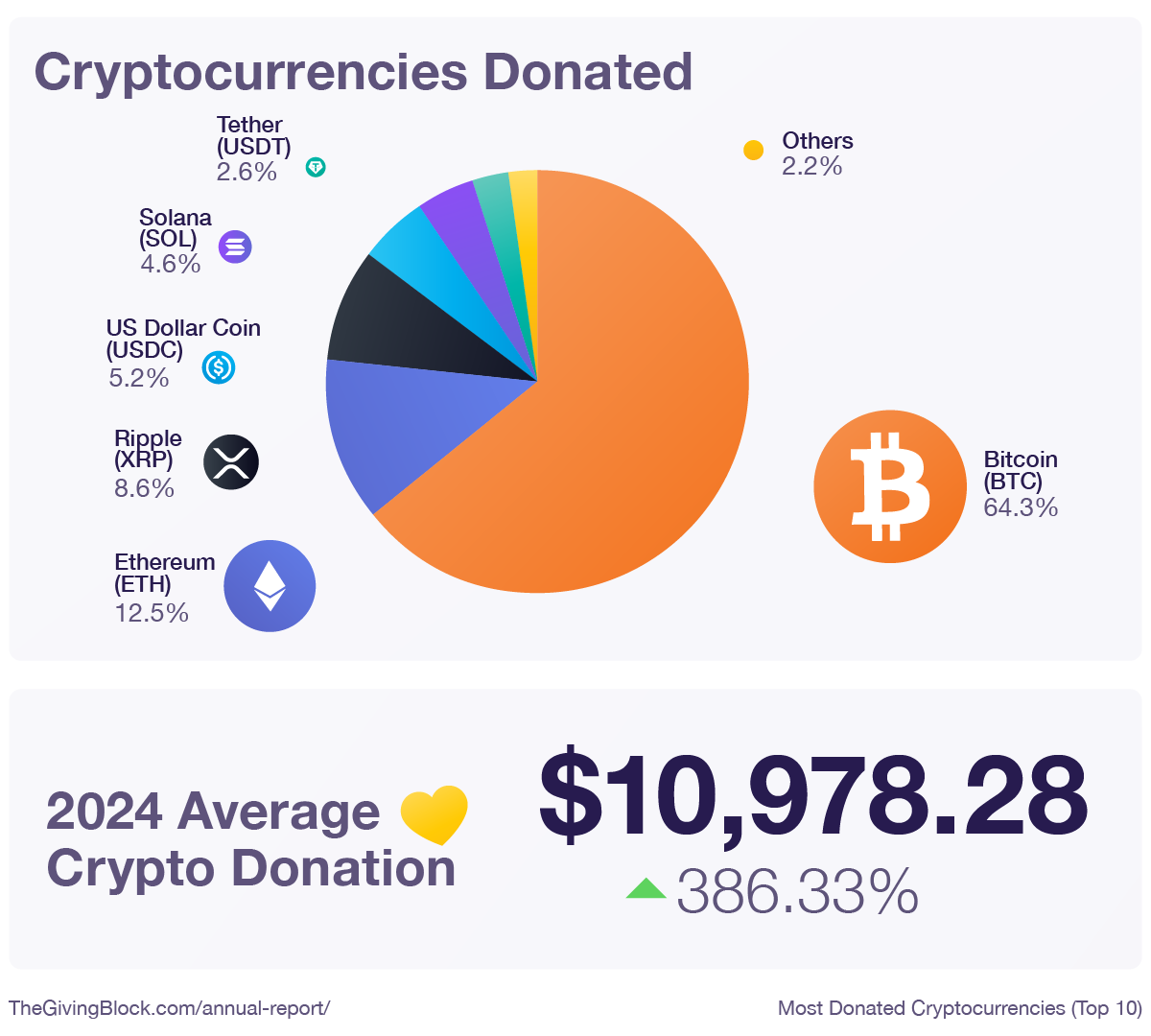
Top Cause Areas Supported by Crypto Donors in 2024
In 2024, crypto donors continued to make a significant impact across a diverse range of causes, with some key areas standing out in total contributions. Education nonprofits received the largest share of crypto donations, totaling 16.0% of all crypto donations through The Giving Block, highlighting the sector’s ongoing importance to donors. Health & Medicine organizations followed closely, securing 13.4%, reflecting strong support for medical research, treatment access, and healthcare initiatives.
Children & Youth nonprofits received 9.9%, emphasizing donor commitment to supporting the next generation, while Animal-related charities saw 9.6%, further proving that crypto donors are passionate about animal welfare and conservation. Women & Girls Empowerment charities received 9.3% of all crypto donations, reflecting continued donor support for initiatives that advance gender equality and opportunities for women and girls worldwide.
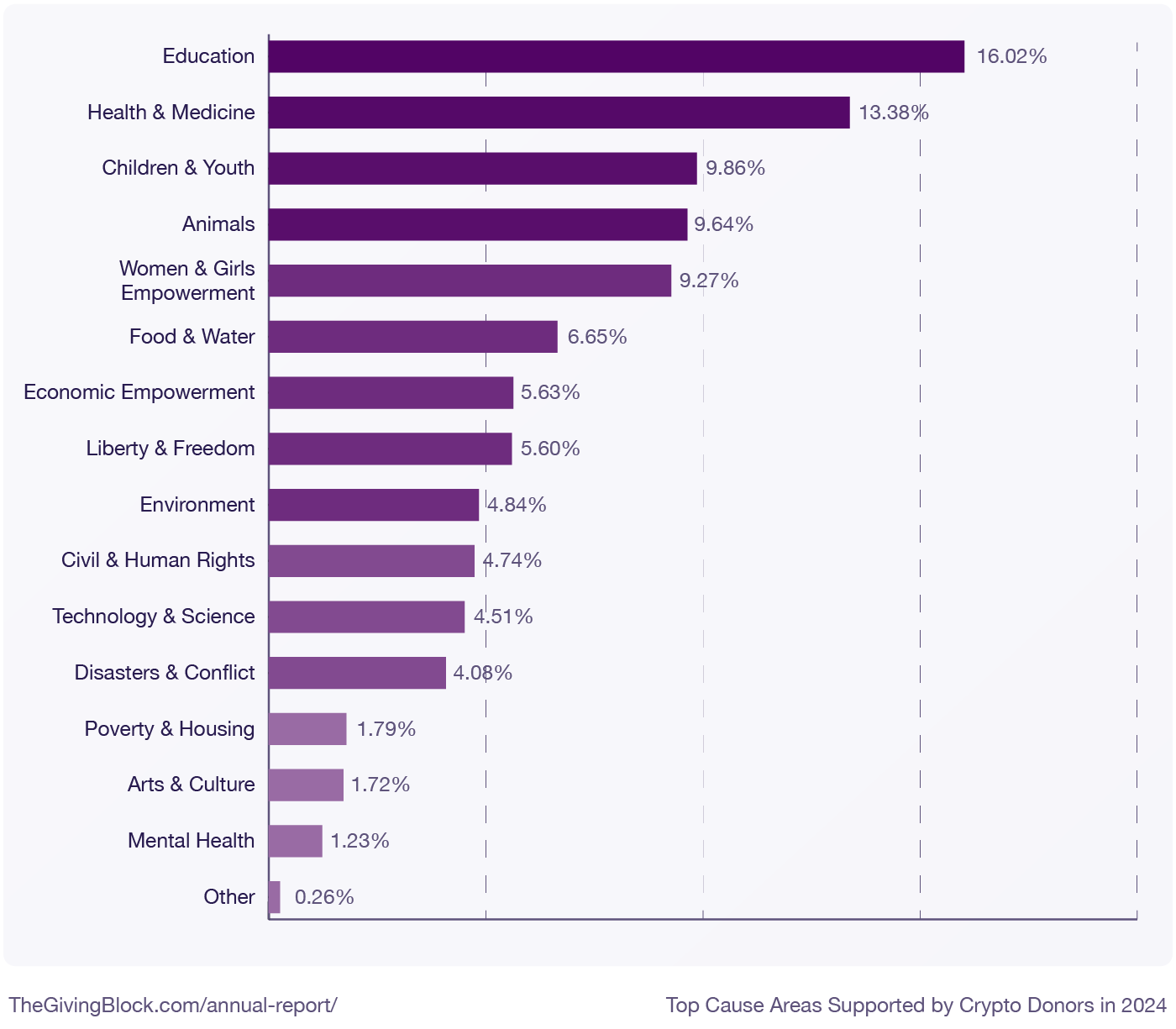
Regional Insights: Fastest-Growing Crypto Giving Adoption
Crypto Philanthropy continues to expand globally, with the United States leading in total crypto donations year over year. Within the U.S., New York maintained its position as the top donating state in both 2023 and 2024, solidifying its role as a hub for crypto giving. Other states also saw impressive growth, with Florida (14.70%), California (13.15%), Pennsylvania (11.02%), and Washington, D.C. (10.06%) rounding out the top five in donation volume.
Historical trends reveal a shifting landscape of crypto giving leadership. Nebraska held the top spot in 2022, while Minnesota led in 2020 and 2021, highlighting how adoption patterns continue to evolve. This data underscores the increasing geographic diversity of crypto donors and the continued rise of digital assets as a mainstream tool for philanthropy.
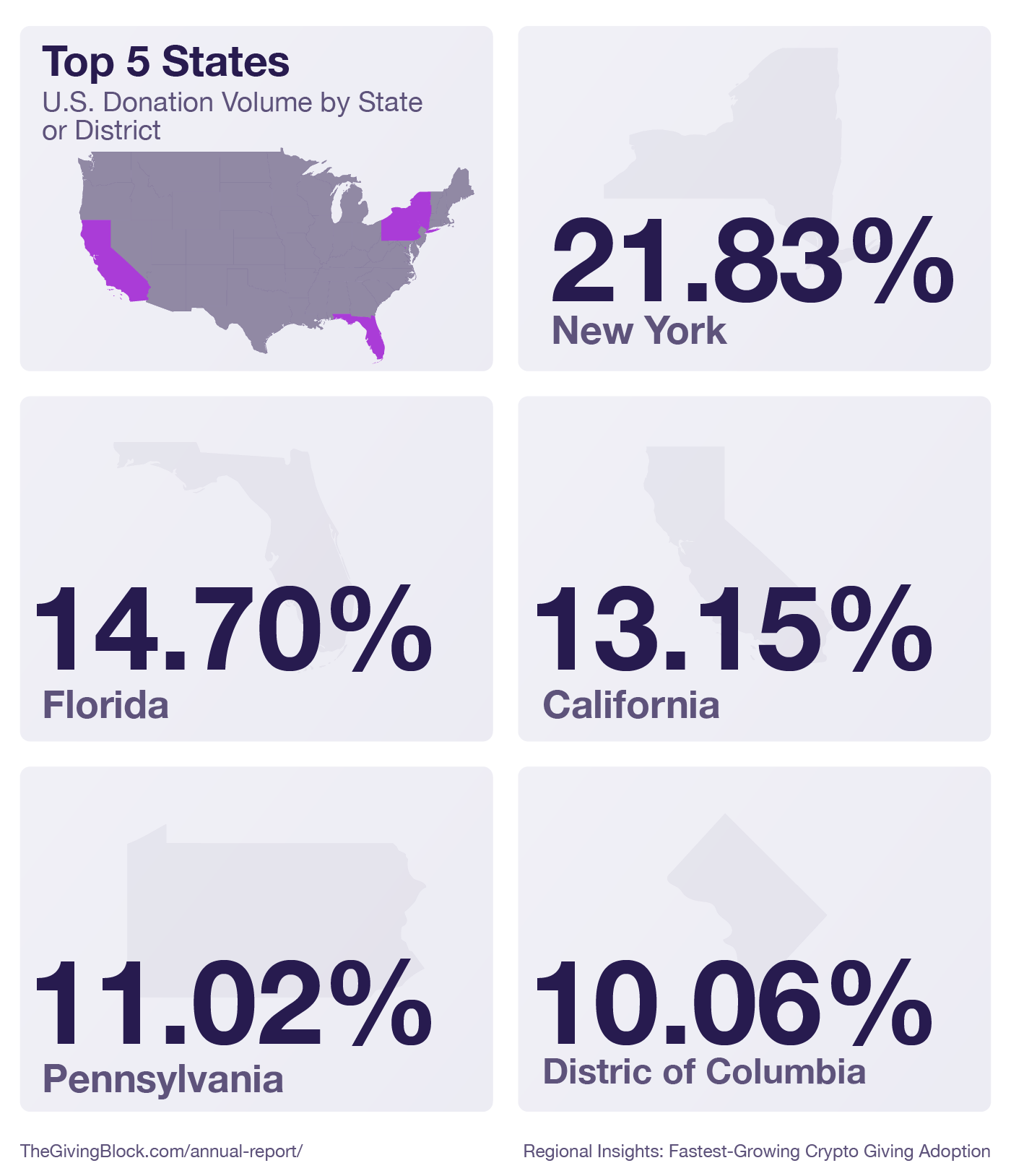
Notable Crypto Donations in 2024
Throughout the year, generous crypto donors have made a lasting difference by supporting nonprofits through The Giving Block. From funding critical animal welfare initiatives to empowering children’s education and strengthening community services, these transformative donations highlight the power of Crypto Philanthropy. This section showcases some of the most impactful contributions, demonstrating how cryptocurrency is fueling meaningful change across a variety of causes.
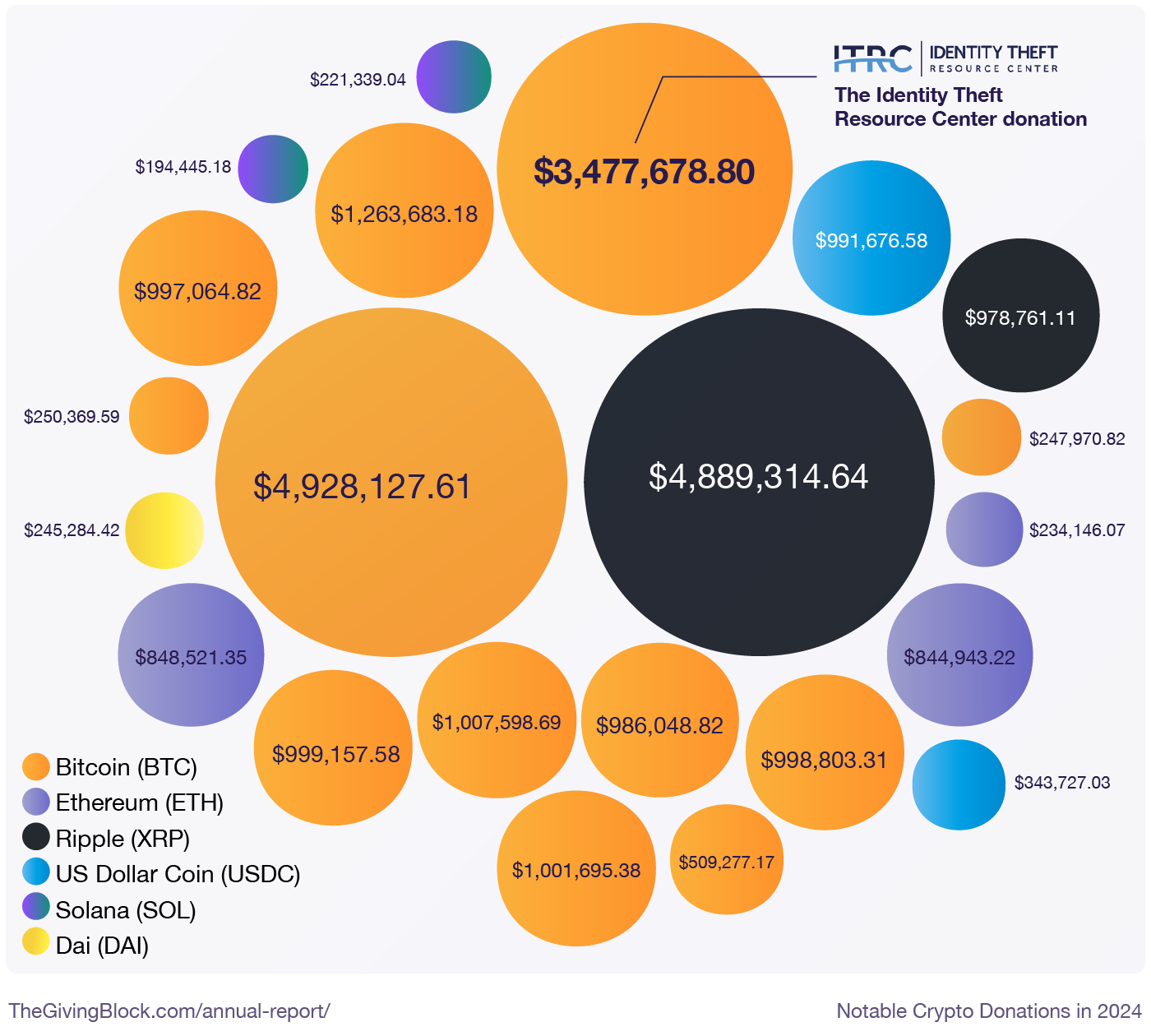
Crypto Market Update
What’s Inside: This section covers what happened in the crypto market in 2024. Learn how 2024 unfolded for crypto in terms of regulatory improvements, integration with traditional financial institutions, and developments in DeFi. What changed, who were the winners and losers, and what were the drivers?
Introduction
2024 marked a pivotal period in the evolution of the cryptocurrency market, characterized by significant advancements in regulation, integration with traditional finance (TradFi), and growth in decentralized finance (DeFi). Despite ongoing market volatility, the crypto space demonstrated resilience and innovation, adapting to changing macroeconomic conditions and increasing guidance from regulators worldwide. As a result, the crypto market grew to new heights, achieving a Bitcoin price that peaked at over $100,000 per unit, and a total crypto market cap of $3.72 trillion.
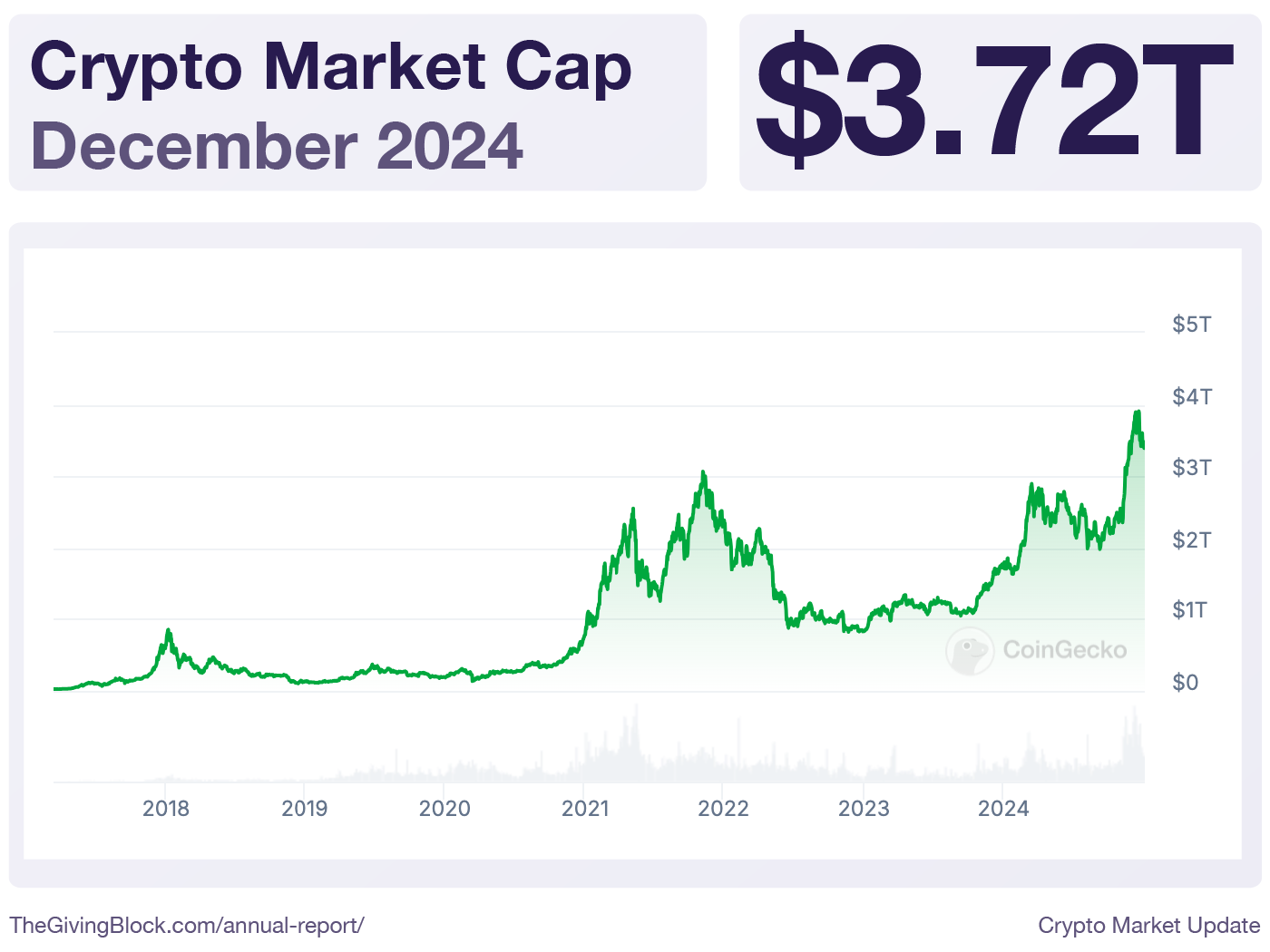
1. Crypto Soars to New All-Time Highs
2024 was a remarkable year for financial markets, with both traditional and crypto experiencing significant growth. Stocks boomed, with the S&P 500 growing 23%, nearly double the stock market’s average annual return over the past two decades (11.87%).
However, despite this strong performance, equities were eclipsed by the explosive growth of the cryptocurrency market. Bitcoin alone outperformed the S&P 500 dramatically , as crypto prices soared to new all-time highs. The total cryptocurrency market capitalization reached $3.72 trillion—30% higher than the peak of the 2021 bull market and more than twice the market cap of silver, underscoring the growing influence of cryptocurrency in the global economy.
A brief breakdown of how some of the top cryptocurrencies performed:
Bitcoin (BTC) ▲147.08%
In 2024, Bitcoin experienced significant growth, increasing by approximately 147.08% over the year according to StatMuse.
- The price of one Bitcoin increased from $43,835.62 on January 1, 2024 to $93,576 on December 31, 2024.
- On December 17, 2024, Bitcoin achieved its highest price of the year at $108,309.
In addition to macro-economic tailwinds, the approval of spot Bitcoin ETFs, heightened institutional adoption, and its role as a hedge against inflation propelled its growth.
Ethereum (ETH) ▲45%
Ethereum saw steady growth in 2024, rising 45% over the year. On March 11, it reached its highest price of the year at $4,031.50.
Ongoing network upgrades enhanced scalability and reduced transaction costs, strengthening Ethereum’s position as the leading smart contract platform. Its continued dominance in decentralized finance (DeFi) and non-fungible tokens (NFTs) further fueled its market performance.
Solana (SOL) ▲100%+
Solana surged over 100% in 2024, outperforming many altcoins. Its growth was fueled by network reliability improvements, partnerships with major Web3 projects, and increasing adoption of decentralized applications (dApps) and non-fungible tokens (NFTs). Solana’s high-performance blockchain, known for its scalability and low fees, continued to attract developers and expand its ecosystem.
Stablecoin usage on Solana hit a record $10 billion, according to DefiLlama, further boosting demand for SOL tokens. Positive sentiment toward alternative layer-1 blockchains positioned as Ethereum competitors also contributed to its price appreciation.
Sui (SUI) ▲512.8%
Sui experienced a remarkable 512.8% growth in 2024, driven by its innovative blockchain technology built on the Move programming language, which introduced advanced scalability and security features. Increased developer adoption played a key role, as more projects leveraged Sui to build decentralized applications (dApps).
Strategic partnerships with major Web3 projects further expanded Sui’s visibility and utility, strengthening its position in the blockchain ecosystem. These factors collectively fueled its rapid price appreciation and growing market presence.
Dogecoin (DOGE) ▲348.9%
Dogecoin surged 348.9% in 2024, driven by ongoing speculation linked to Elon Musk’s association with the Department of Government Efficiency. This connection fueled renewed investor interest and market momentum.
Increased payment adoption also played a key role, with merchant partnerships and integration into payment platforms expanding its real-world use cases. Additionally, Dogecoin’s loyal community maintained strong engagement, driving consistent trading volume and price growth.
Ripple (XRP) ▲296.7%
Ripple saw a 296.7% surge in 2024, largely driven by legal clarity following its partial victory against the SEC, which boosted investor confidence. Additionally, institutional adoption grew as financial institutions increasingly used XRP for cross-border payments, reinforcing its utility in global finance.
Regulatory developments further supported its growth, with favorable clarity in multiple jurisdictions enhancing adoption. Anticipation of a change in SEC leadership also contributed to positive market sentiment, strengthening XRP’s position.
Hedera (HBAR) ▲228.1%
Hedera climbed 228.1% in 2024, driven by enterprise adoption as more companies leveraged its secure and scalable blockchain solutions. Its appeal as a high-performance network attracted institutional use cases, reinforcing long-term growth.
Additionally, Hedera expanded into decentralized finance (DeFi) and NFTs, increasing activity on its network. This broader ecosystem development contributed to rising demand for HBAR, fueling its price appreciation.
Stablecoins
Stablecoins also had a standout year with their circulation increasing to approximately $200 billion. Even more impressively, stablecoins processed nearly $30 trillion in transactions in 2024, surpassing major payment networks like Visa ($11 trillion) and Mastercard ($2 trillion) combined.
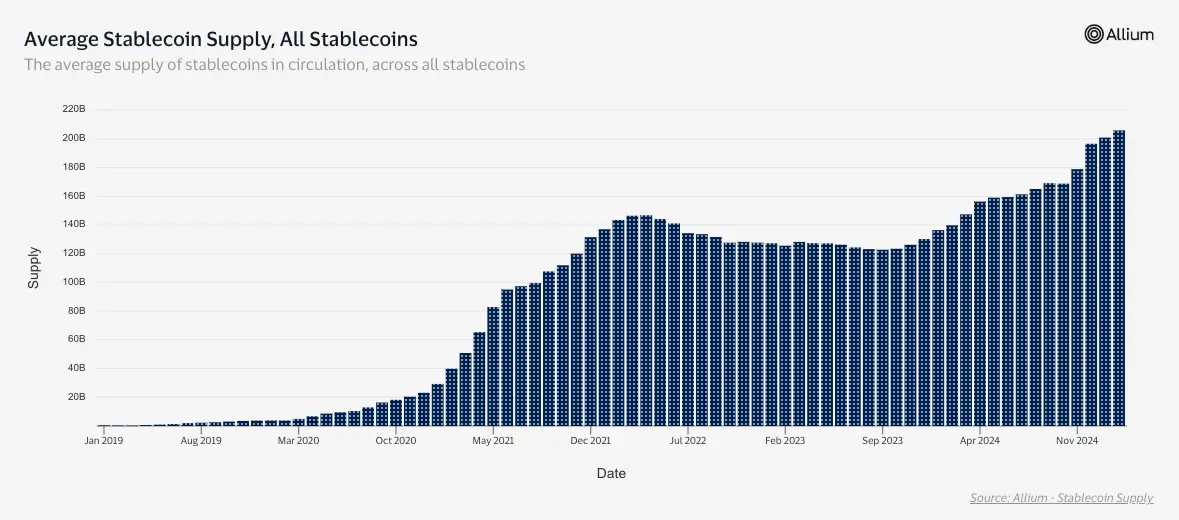
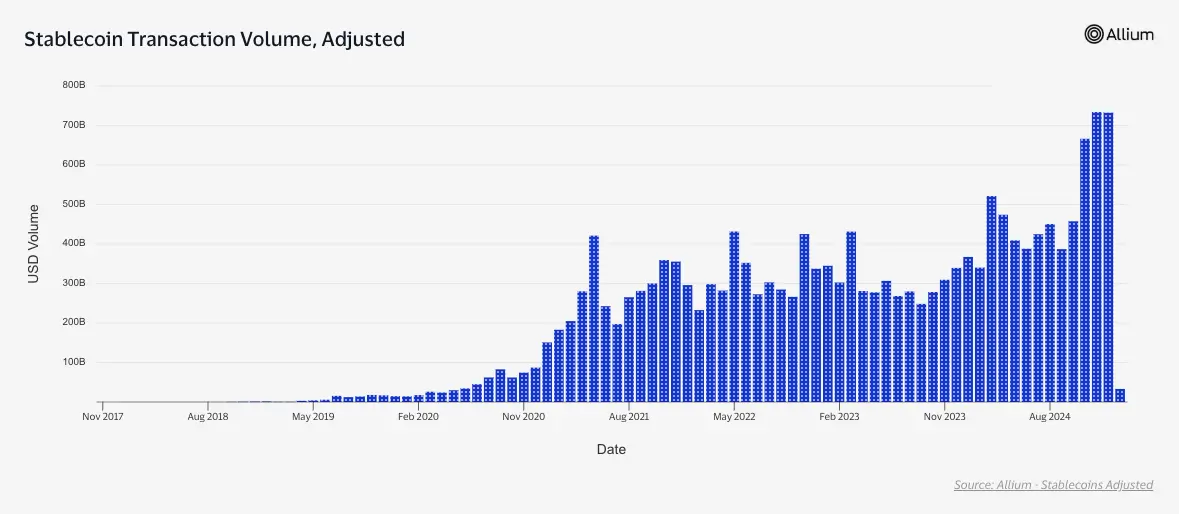
In the stablecoin market, Tether (USDT) and USD Coin (USDC) remained king and accounted for the majority of the supply and transaction volumes.
Tether (USDT)
As of August 2024, Tether’s market capitalization stood at approximately $114.4 billion, according to CoinGecko. Over the past few months, stablecoin transactions across various blockchains exceeded $30.1 trillion, with USDT accounting for 66.7% of total transactions. Alongside USD Coin (USDC), which held 33%, these two stablecoins now command nearly 100% of the stablecoin market share.
USDT’s dominance remained strong due to its status as the preferred stablecoin for traders, providing critical liquidity across exchanges. Additionally, global adoption continued to rise as Tether solidified its presence in various regions, further bolstering transaction volumes.
USD Coin (USDC)
USD Coin had a market capitalization of $33.3 billion as of August 2024, according to CoinGecko. In April 2024, USDC briefly overtook Tether in transaction volume, based on data compiled by Visa and reported by Bloomberg.
USDC’s growth was fueled by institutional integration, with financial institutions and payment processors like Visa incorporating it into their systems. Its reputation for regulatory transparency and compliance also attracted users prioritizing stability and security in the stablecoin market.
2. Regulatory Landscape
In 2024, cryptocurrency regulation saw significant advancements worldwide, fostering a more structured and transparent environment for investors, developers, and institutions.
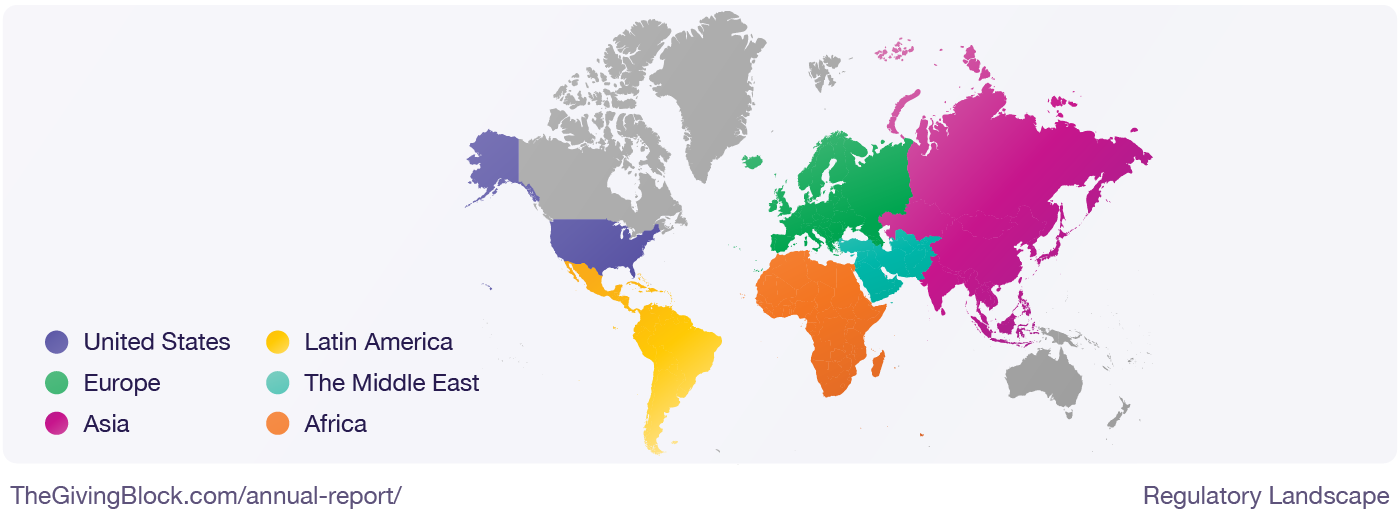
United States
The SEC approved the first spot Bitcoin and Ethereum ETFs, a watershed moment for the integration of crypto into traditional finance. Additionally, we saw increased regulatory clarity for the leading exchange platforms, setting the stage for new, compliant crypto products.
The new Trump administration pledged to improve crypto regulations, providing a clearer and more equitable framework for businesses and investors.
Europe
The European Union fully implemented its Markets in Crypto-Assets (MiCA) regulation, creating a standardized regulatory framework across all member states. MiCA aims to foster innovation and strengthen investor protection, positioning the EU as a leader in crypto.
Asia
Hong Kong and Singapore solidified their status as crypto hubs, introducing clear licensing pathways and attracting institutional investors and Web3 startups. India launched a pilot program for a retail central bank digital currency (CBDC) while maintaining its stringent crypto taxes, which continue to impact retail adoption.
Latin America
Argentina, amid ongoing economic instability and high inflation, saw increased reliance on crypto as a hedge against currency devaluation. The newly elected Milei administration took a pro-crypto stance, pushing for deregulation and promoting Bitcoin and stablecoins as viable alternatives to the peso.
Brazil created clearer guidelines for digital asset service providers, fostering institutional investment. The country’s central bank advanced its digital real pilot program(DREX), exploring the role of blockchain in financial inclusion and payment efficiency.
The Middle East
The Middle East made significant strides in crypto regulation and adoption in 2024, with the United Arab Emirates leading the way through comprehensive rulebooks and regulatory frameworks. Qatar and Saudi Arabia have also taken notable steps, with Qatar introducing foundational digital asset regulations and Saudi Arabia considering a central bank digital currency while deeming cryptocurrencies Sharia-compliant.
Africa
Africa is experiencing notable crypto growth, with Nigeria and South Africa developing regulations expanding crypto usage across the continent. Crypto exchange Yellow Card has emerged as the continent’s top platform, leading the creation of a framework across nations and driving stablecoin adoption for low-cost transactions, and storing wealth as a hedge against inflation.
3. Traditional Finance (TradFi) Integration
The integration of cryptocurrency into traditional finance (TradFi) accelerated in 2024, further legitimizing cryptocurrency and increasing its accessibility to mainstream investors.
Institutional Adoption
One of the most significant milestones in 2024 was the approval of several spot Bitcoin ETFs by U.S. regulators, providing institutional and retail investors with a regulated and accessible way to gain exposure to Bitcoin without the complexities of direct custody. These ETFs saw strong inflows, signaling robust demand for crypto investment vehicles and reinforcing Bitcoin’s status as a legitimate asset class.
Beyond ETFs, major financial institutions expanded their involvement in digital assets:
- JPMorgan and Goldman Sachs deepened their crypto trading operations, offering new derivatives and structured products for institutional clients.
- Fidelity and BlackRock continued expanding their digital asset divisions, launching new funds tailored to high-net-worth individuals and institutional investors.
- State Street and BNY Mellon, two of the world’s largest custodians, enhanced their digital asset custody services, providing institutional-grade security for Bitcoin, Ethereum, and tokenized assets.
Payments
Cryptocurrency is no longer just an investment asset—it’s becoming a mainstream payment method. In 2024, new payment solutions and partnerships between crypto companies and traditional financial institutions made it easier than ever for businesses and consumers to use cryptocurrency for everyday purchases.
Major payment providers have integrated cryptocurrency into their platforms, enabling seamless transactions between crypto users and merchants:
- Shift4’s Pay with Crypto: Shift4, a leading payments technology provider, introduced its Pay with Crypto solution, allowing businesses to accept Bitcoin, Ethereum, and stablecoins at checkout. Merchants benefit from instant conversions to fiat currency, eliminating volatility risks.
- Stripe’s Crypto Payments: Stripe relaunched its crypto payments functionality in 2024, enabling businesses to accept stablecoin payments (primarily USDC) across e-commerce platforms, marketplaces, and subscription services. Stripe’s integration allows merchants to automatically convert crypto payments into their preferred currency.
- PayPal’s Stablecoin (PYUSD) Expansion: PayPal expanded the adoption of PYUSD, its own U.S. dollar-backed stablecoin, making it a preferred method for transactions within its global payment ecosystem.
- Visa and Mastercard’s Crypto Integration: Both companies have deepened their stablecoin support, allowing businesses to settle transactions in USDC and USDT on their global payment networks.
Partnerships
Traditional financial institutions increasingly partnered with blockchain firms to leverage the benefits of distributed ledger technology (DLT) for asset tokenization, settlement efficiency, and cross-border payments. Key collaborations in 2024 included:
- BlackRock and Securitize, which expanded their tokenization initiatives, launching blockchain-based funds to enhance liquidity and accessibility in private markets.
- Citigroup’s partnership with Avalanche, aimed at optimizing institutional-grade blockchain settlement solutions for global trade finance.
- Visa and Mastercard, which continued integrating stablecoin payments, particularly USDC and USDT, into their global payment networks, allowing merchants to accept digital currencies seamlessly.
- SWIFT and Chainlink, which tested interoperability solutions to bridge traditional banking systems with blockchain networks, paving the way for faster, more transparent global transactions.
4. Decentralized Finance (DeFi)
Decentralized Finance (DeFi) continued to expand in 2024, driven by new technology, wider adoption, and growing interest from both individual users and institutions.
New Technology and Upgrades
DeFi platforms became more efficient and user-friendly thanks to improvements in blockchain technology:
- Ethereum Upgrades: The Shanghai and Cancun upgrades improved Ethereum’s ability to handle transactions, making them faster and cheaper. This made DeFi more accessible and encouraged more people to use Ethereum-based financial services.
- Layer-2 Networks: Networks like Arbitrum and Optimism helped reduce congestion on Ethereum by processing transactions off the main blockchain before finalizing them. This meant faster transactions at lower costs, increasing the popularity of DeFi applications.
Trusted Institutions
Traditionally, DeFi has been popular among individual crypto users, but in 2024, larger financial institutions began exploring it as well:
- Yield Generation: Institutions such as JPMorgan, Goldman Sachs, and Franklin Templeton started using DeFi platforms for decentralized lending, where they could earn interest on their crypto holdings.
- Liquidity Pools: Some financial firms also participated in liquidity pools—pools of funds that help DeFi platforms run smoothly while allowing participants to earn passive income.
Regulatory Developments
As DeFi became more mainstream, regulations became a bigger focus:
- Some DeFi platforms introduced Know-Your-Customer (KYC) rules, requiring users to verify their identities before using certain services.
- While this created friction with those who value DeFi’s original focus on privacy and decentralization, it also made the sector more attractive to institutions that require compliance with global financial regulations.
Overall, 2024 was a year of growth and adaptation for DeFi, as technology improvements made it more efficient, institutions started getting involved, and regulatory changes pushed platforms toward a balance between compliance and decentralization.
5. Macroeconomic Factors Shaping Crypto in 2024
Global economic trends had a major influence on the cryptocurrency market in 2024, with investors turning to cryptocurrency in response to inflation, geopolitical uncertainty, and technological advancements.
Inflation and Interest Rates
Inflation remained high, prompting central banks—especially the U.S. Federal Reserve and the European Central Bank—to keep interest rates elevated to curb rising prices.
With traditional investments like bonds and savings accounts offering limited returns, many investors turned to Bitcoin and other cryptocurrencies as alternative stores of value, reinforcing Bitcoin’s reputation as “digital gold.”
Geopolitical Tensions and Crypto Adoption
Ongoing conflicts and economic sanctions led to increased reliance on cryptocurrencies as a borderless and censorship-resistant means of transferring wealth.
In regions facing economic instability and currency devaluation, such as parts of Latin America and Eastern Europe, crypto adoption surged as individuals and businesses sought financial alternatives outside of traditional banking systems.
Tech Advancements Driving Investment
Artificial Intelligence (AI) helped investors make better decisions by analyzing market trends and predicting price movements. These AI tools also helped reduce risks, making crypto investments more appealing to large companies and financial institutions.
Easier Blockchain Connections: Normally, different cryptocurrencies and blockchain systems operate separately, like apps that don’t work together. In 2024, new technology allowed these systems to communicate and work with each other, making crypto platforms more user-friendly and practical.
More Useful Crypto Apps: Because blockchains could now connect more easily, developers were able to build better apps for things like trading, lending, and payments. This made cryptocurrencies more useful in everyday life.
CBDC Developments
The rollout of CBDCs in multiple countries raised awareness about digital currencies, indirectly benefiting the broader crypto market.
Crypto Donors: Who Are They and What’s Changing?
What’s Inside: This section answers the question, “Who are crypto donors?” From their demographics to what motivates their giving, we dive into the different types of donors who give crypto and what makes them tick.
One of the most common questions we get from nonprofits is, “Who are crypto donors?”
In most cases, every nonprofit already has crypto donors but they just don’t know it yet because they haven’t asked. Crypto donors are unique because they are still their own donor demographic in many ways.
For now, crypto donors are typically younger than the average donor (often in their 20s and 30s) but still wealthier and more philanthropic than the average donor. Because of this, nonprofits get the best of both worlds. They get a young donor who has the capacity to give large gifts while also having a lifetime ahead of them to build a relationship with the causes they care about.
Crypto donors generally fall into two primary categories: Crypto Evangelists and Optimistic Investors. Crypto Evangelists are deeply passionate about the transformative potential of blockchain technology and view Crypto Philanthropy as a means to advance mainstream adoption while making a positive societal impact. Many of these donors are long-time holders who experienced significant gains and want to “pay it forward,” aligning their giving with their belief in the decentralized future of finance. On the other hand, Optimistic Investors are primarily motivated by the financial advantages of donating crypto, such as reducing taxable gains while supporting causes they care about. Often younger and focused on maximizing returns, these donors see crypto donations as a strategic way to align tax efficiency with philanthropic goals. Both groups are tech-savvy, forward-thinking, and highly impactful in driving the growth of Crypto Philanthropy.
Although these donors are already fairly wealthy, their wealth is set to explode and this trend is going to accelerate. Not only has crypto been the best performing asset class in the last 5 and 10 year period, but there is a great wealth transfer happening that is shifting wealth from boomers to Millennials and Gen Z reported by Merrill Lynch. $84.4 trillion is set to be transferred in wealth to younger people and studies show that they prefer to invest their wealth in digital assets like Bitcoin instead of stocks and bonds, reported by Ledger Insights.
As crypto has become more accessible and popular, crypto has become an increasingly common part of many investors’ portfolios. It used to be hard to buy crypto and hold it as an investment 5-10 years ago. Now it’s as easy as buying a stock in your brokerage account, or buying shoes online. Over time, crypto donors will start to be your “average donor” because everyone will own some crypto.
Although crypto donors still look a bit different than the average donor today, as time goes on and crypto continues to go more mainstream, every donor will be a potential crypto donor.
Nonprofits: 2024 Results & Case Studies

The Identity Theft Resource Center (ITRC)
The Identity Theft Resource Center received a $1.4 million Bitcoin donation in May 2024. Later, they received an additional $2 million in Bitcoin, totaling $3.4 million. This success highlights The Giving Block’s expertise and trust in facilitating large cryptocurrency donations for nonprofits.

Friends of Bonobos
In 2021, Friends of Bonobos began accepting cryptocurrency donations through The Giving Block, inspired by a donor’s inquiry. This initiative has been highly successful, raising over $240,000 in crypto donations, including a significant $77,500 gift from the Bored Ape Yacht Club. These funds support vital bonobo care, rewilding efforts, and anti-poaching initiatives.

Oceanic Society
Oceanic Society, a 55-year-old ocean conservation leader, embraced cryptocurrency donations in 2020. This innovative approach has raised over $100,000, contributing significantly to their “Ripples of Change” campaign, which aims to raise $600,000 by their 60th anniversary in 2029. This success demonstrates the potential of cryptocurrency to support crucial ocean conservation efforts and the trust older institutions are putting on this movement.

Make-A-Wish International
Make-A-Wish International has raised nearly $400,000 in crypto, granting 1,000 wishes and expanding its global reach with new offices in Ecuador and Indonesia.

SEE Turtles
SEE Turtles has raised over $175,000 in crypto donations through The Giving Block. This significant funding supports vital sea turtle conservation efforts in 15 countries, including the ambitious “Billion Baby Turtles” project.
2025 Recommendations & Forecast (Market | Crypto Philanthropy)
What’s Inside: This section explores the 2025 crypto market forecast, with Bitcoin price projections and its impact on philanthropy. We analyze key growth drivers, accessibility challenges, and recommendations for nonprofits and donors, highlighting an estimated $2.5 billion in crypto donations and strategies to maximize impact.
Crypto Market Forecast
Today, there is more money invested in cryptocurrencies than in any company on the stock market. By the end of 2024, there was roughly $3.54 trillion invested in cryptocurrencies. Analysts believe that the crypto market cap could reach up to $10 trillion in 2025 according to ITC.
- Tom Lee (Fundstrat): Predicts Bitcoin could reach $250,000 within the next 12 months, citing the halving event as a fundamental catalyst.
- Matthew Sigel (VanEck): Anticipates Bitcoin will hit $180,000 in 2025, based on Bitcoin’s recurring four-year pattern.
- Robert Kiyosaki: Projects Bitcoin could reach $350,000 by 2025, viewing it as a hedge against traditional financial uncertainties.
- Bernstein Research: Forecasts Bitcoin could climb to $200,000 by the end of 2025, driven by a “new institutional era.”
- C. Wainwright & Co.: Revised its 2025 Bitcoin price target to $225,000, considering historical trends and macroeconomic signals.
- Standard Chartered: Predicts Bitcoin could reach $250,000 by the end of 2025, influenced by institutional adoption and potential U.S. strategic reserve considerations.
- Bitfinex: Suggests Bitcoin’s price may approach $200,000 by mid-2025, drawing parallels to previous market cycles.
- HashKey Group: Predicts Bitcoin could surpass $300,000 by 2025, highlighting regulatory advancements and technological innovations.
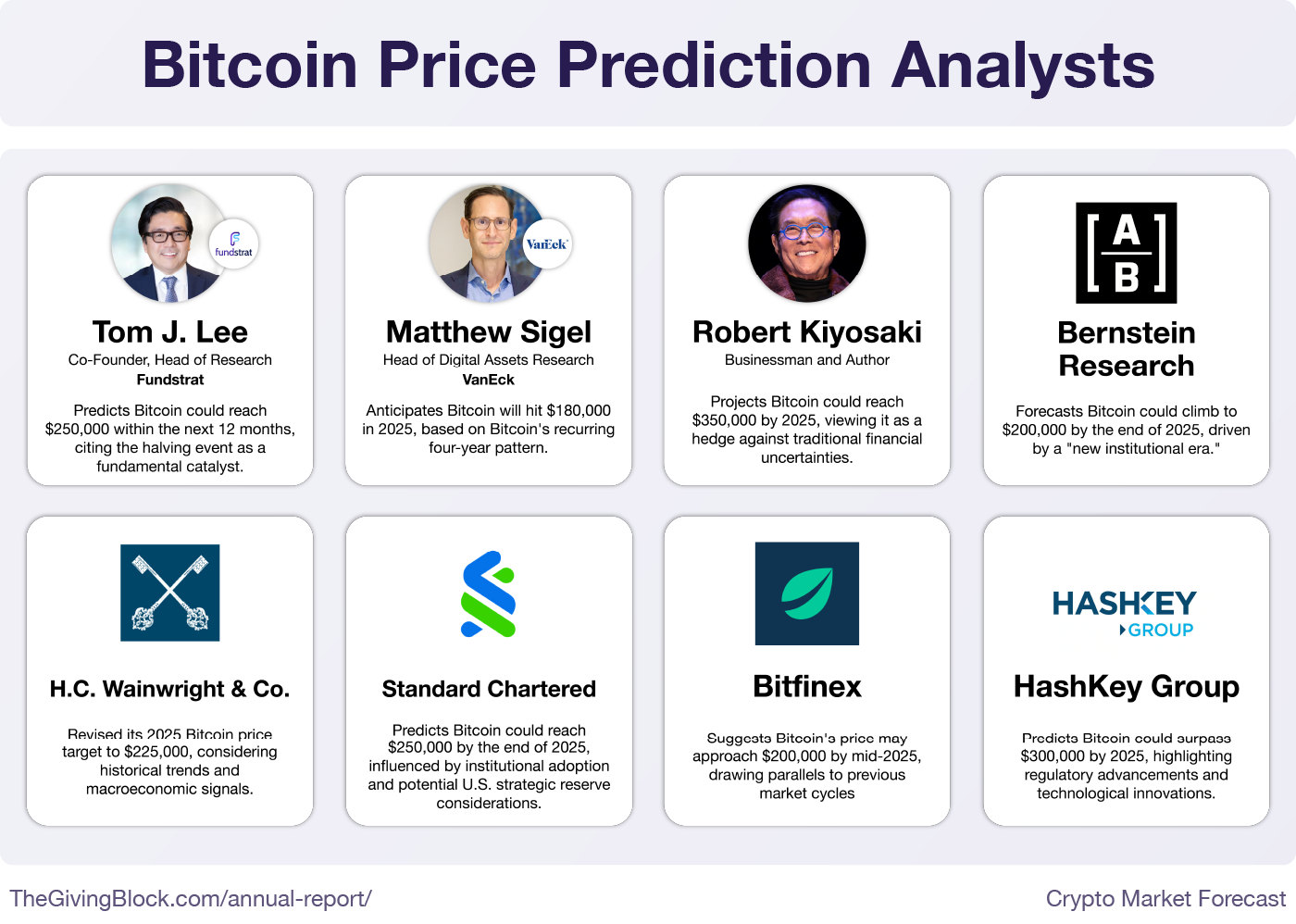
To be more conservative, let’s say the market cap grows to only $5 trillion. That would represent about a 41% increase in the crypto market cap, outperforming the S&P 500 yet again, and making one Bitcoin worth about $141,000. Though this is not financial advice, and it’s impossible to predict asset prices with certainty, we feel that the bullish sentiment from analysts, and the supportive political environment, make this a reasonable number to use as the basis of our Crypto Philanthropy forecast.
Crypto Philanthropy Forecast
Total Giving Potential in 2025
The total crypto giving potential in 2025 is expected to grow significantly as mainstream adoption of cryptocurrency continues to expand. With the favorable political climate, the increasing accessibility and broader institutional acceptance, crypto wealth generation is set to rise, leading to a larger pool of high-net-worth individuals looking for tax-efficient charitable giving strategies.
With a stock market cap of about $55.2 trillion, and about $30 billion donated in stocks to nonprofits each year according to Infinite Giving, the ratio of Market Cap:Total Giving is about 0.05%. With a crypto market cap of $5 trillion, we would expect to see about $2.5 billion in crypto donated in 2025.
The Need for Accessibility Improvements
Stock and crypto giving remain extraordinarily inaccessible on nonprofit websites today. If credit card donation options were equally difficult to locate and execute, total donation volume to nonprofits would likely be significantly lower. Yet, a substantial number of nonprofits continue to face key challenges in optimizing these giving methods, including:
- Limited visibility in fundraising appeals, reducing awareness and donor engagement.
- Poor website accessibility, particularly in mobile experiences, making it difficult for donors to locate these giving options.
- Outdated transaction processes, relying on legacy methods such as brokerage accounts, PDFs, phone calls, email exchanges, and manual tracking—approaches typically suited only for donors over 60 or their financial advisors.
This is the digital equivalent of hiding a store’s check out in the employee lounge, and then presenting the few customers determined enough to find it with a phone number they can call if they’d like to buy the items they’ve placed in their basket. Simply solving the accessibility barriers alone could easily result in a 5-10x increase in donations made via both assets.
Growth Drivers
Several key factors will influence the trajectory of Crypto Philanthropy in 2025. As adoption expands, the ability of nonprofits to effectively integrate crypto donations into their fundraising strategies will be critical. Additionally, external market conditions will play a significant role in shaping donor behavior. The most significant variables include:
- Enhanced Accessibility: Increasing the number of nonprofits that prominently feature crypto donation options in their appeals and on primary donation pages will drive higher engagement and contributions.
- Market Performance: Fluctuations in market performance will impact donor generosity, particularly during the high-volume December giving season, as donors look to optimize their tax strategies in response to market conditions.
Which Cryptocurrencies Will Be the Most Donated?
While Bitcoin (BTC) will continue to dominate crypto donations due to its widespread adoption and continued appreciation, the following trends are emerging:
- Ethereum: As the second-largest cryptocurrency, Ethereum continues to see strong adoption for donations, particularly as it remains a leading asset in the blockchain ecosystem.
- Stablecoins (USDC, USDT, DAI): Due to their stable values and growing popularity due to regulatory clarity, stablecoins are becoming a preferred choice for crypto donors who aren’t interested in transferring appreciated assets.
- Solana (SOL): With its growing ecosystem and lower transaction fees, Solana is positioned to gain traction in philanthropy as it’s emerged as a top 5 cryptocurrency by market cap.
- XRP: XRP has a long history of being philanthropic. As the third largest cryptocurrency by market cap, we expect that trend to continue and accelerate as the price continues to appreciate this year.
- Memecoins: Dogecoin (DOGE), Bonk (BONK), Shiba Inu (SHIB), Pepe (PEPE) and other major memecoins have appreciated greatly and have an ongoing history of charitable giving.
Which Nonprofits Will Raise the Most?
The nonprofits that will benefit the most from Crypto Philanthropy in 2025 will fall into the following categories:
- Humanitarian Aid & Disaster Relief: Organizations that provide rapid response services are likely to see significant donations, as crypto allows for fast, borderless transfers. We’re seeing new companies like Coala Pay emerge on this front.
- Educational Institutions & Scholarships: Universities and schools expanding their Web3 initiatives will attract younger donors invested in the crypto ecosystem. There is an increasing number of cryptocurrency related courses offered at colleges and universities including Massachusetts Institute of Technology (MIT), Harvard University, and University of California, Berkeley to name a few.
- Environmental & Climate Change NGOs: Young donors alignment with climate initiatives has historically driven large donations and we expect this trend to continue.
- Faith-Based Organizations: Churches and other faith based organizations have seen a boom in cryptocurrency donations given their high levels of funding. We expect this trend to accelerate and more churches go through a digital transformation.
- Decentralized Research & Science (DeSci) Charities: Crypto donors like to fund new and interesting ideas or research. Crypto donors interested in scientific progress and decentralized funding models will support these initiatives.
Which Factors Could Impact Results?
The landscape of Crypto Philanthropy is shaped by a mix of external forces and strategic decisions. While macro-level trends like regulatory shifts and ETF adoption influence donor behavior, nonprofits also have the power to drive results through targeted campaigns and optimized fundraising strategies. Understanding both sides of the equation is key to maximizing impact in an evolving market.
Some factors, like crypto market performance and economic conditions, are beyond our control, but nonprofits can still take proactive steps to strengthen their digital presence, refine their appeals strategy, and enhance the donor experience. Below, we break down the key external and internal factors that could influence crypto fundraising results.
External Factors:
- Regulatory Environment: Changes in SEC policies, global crypto regulations, and taxation laws may impact the willingness of donors to give crypto.
- ETF Market Growth: With Bitcoin and Ethereum ETFs gaining traction, institutional inflows could stabilize market prices, leading to larger, more predictable crypto donations. The Bitcoin ETF was the most successful ETF launch in history.
- Crypto Market Performance: A bullish market may encourage more charitable giving due to wealth effects, while a downturn could reduce donor enthusiasm.
- Global Economic Conditions: Inflation rates, interest rates, and economic uncertainty will influence philanthropic trends overall.
Internal Factors:
- Giving Experience & Conversion Optimization: Enhancing donation processes to be seamless, secure, and user-friendly across platforms.
- Discoverability & Retention: Ensuring nonprofits have visibility on major crypto giving platforms (e.g., Twitter/X, The Giving Block, Crypto Giving Tuesday).
- Appeals Strategy & Timing: Leveraging major market events (e.g., year-end tax planning, bull runs, crypto holidays like Bitcoin Pizza Day) to maximize impact.
- Matching Donations & Incentives: Encouraging donor participation through match campaigns.
- Digital Presence & CRM Management: Strengthening nonprofit visibility through engagement, stewardship strategies, and improved donor retention initiatives.
Strategic Recommendations for Nonprofits
Charities
The growing adoption of cryptocurrency presents a significant opportunity for charities to modernize their fundraising strategies and reach a new generation of donors. By integrating crypto into existing development initiatives, nonprofits can position digital asset donations as part of a broader shift toward innovation and financial accessibility. Accepting crypto through multiple platforms ensures ease of transaction, while leveraging emerging trends such as NFT fundraising and DeFi-based philanthropy can unlock additional revenue streams.
Donor Education
Crypto’s tax advantages—such as avoiding capital gains taxes—provide donors with a compelling reason to contribute, making it essential for charities to educate supporters on these benefits and provide clear, crypto-specific tax-deductible receipts.
Impact Stories
Showcasing impact stories funded through crypto donations further strengthens donor engagement, demonstrating how Crypto Philanthropy directly supports mission-driven initiatives. As crypto continues to break down geographic barriers, nonprofits can expand their donor base globally, engaging new supporters who value both financial innovation and social impact.

American Foundation for Suicide Prevention
In 2021, the American Foundation for Suicide Prevention (AFSP) embraced cryptocurrency donations, raising over $400,000, including a significant contribution of approximately $220,000 from the NFT project “Trippy Bunny.” This initiative not only diversified AFSP’s revenue streams but also connected them with new communities supporting suicide prevention.

CARE
After partnering with The Giving Block, CARE, an organization dedicated to fighting global poverty, engaged in an NFT fundraising project that led to a substantial increase in their donation volume, surpassing their initial expectations.

VaynerNFT
To assist Stella Artois in launching a charitable NFT project, VaynerNFT facilitated connections with creators and provided crypto fundraising solutions, ensuring a successful NFT drop and subsequent charitable donation to water.org

Punks vs. Apes
In September 2022, the Bored Ape Yacht Club and CryptoPunks collaborated in a two-day charity event called “Punks vs. Apes,” raising over $55,000 in crypto donations for Riley Children’s Hospital. This event highlighted the potential for NFT projects to unite for philanthropic causes.

She’s the First
During the COVID-19 pandemic, She’s the First explored crypto fundraising, which enabled them to establish a new revenue stream to support their global operations focused on empowering young women.

Built With Bitcoin
The Built With Bitcoin Foundation accepts cryptocurrency donations to advance its mission of building communities in need. Partnering with The Giving Block has furthered their efforts to transform communities worldwide.
2025 Forecast for Charities
With cryptocurrency gaining mainstream acceptance and the market experiencing a bullish cycle, nonprofits that proactively adopt crypto giving strategies stand to benefit significantly. Wealthy crypto holders are increasingly seeking philanthropic opportunities that align with their financial planning and impact-driven goals. By embedding Crypto Philanthropy into digital transformation strategies, charities can future-proof their donor engagement, ensuring long-term sustainability in an evolving fundraising landscape.
Universities & Schools
As cryptocurrency reshapes global finance, universities and educational institutions are uniquely positioned to engage crypto donors, particularly alumni in the tech and blockchain sectors. By offering scholarships funded through crypto endowments, universities can support students pursuing careers in blockchain, fintech, and emerging technologies.
Actively Offer Alumni the Crypto Option
Educating alumni networks on the benefits of crypto giving—including its tax efficiency and potential for long-term growth—can foster sustained philanthropic contributions.
Embrace Blockchain Innovation
Universities can lead in blockchain innovation by partnering with industry, gamifying crypto donations, and engaging younger donors. Investing endowments in digital assets can also drive long-term financial growth amid increasing institutional adoption of crypto.
Fundraise Crypto for Real World Impact
The University of Arizona Foundation embraced crypto fundraising, establishing new giving options for alumni and receiving immediate benefits from this modern revenue stream. The university was averaging $21,833 of monthly crypto donation volume with limited external marketing driving the fundraising efforts.
In 2022, The University of Maryland received $9.4 million worth of ETH from Ethereum co-founder Vitalik Buterin. This gift came from Buterin’s Balvi Filantropic Fund and was the largest crypto donation ever given to a U.S. university. The donation supported the School of Public Health’s research into germicidal ultraviolet light (GUV) led by the Public Health AeroBiology Labratory (PHAB Lab).
2025 Forecast for Universities & Schools
Universities that embrace cryptocurrency philanthropy can strengthen engagement with younger alumni, tech industry leaders, and blockchain entrepreneurs. The bullish market presents an opportunity to expand scholarship funding, invest in cutting-edge research, and enhance endowment growth. By integrating crypto into long-term fundraising and investment strategies, educational institutions can maintain a competitive edge while aligning with the evolving financial preferences of their donor base.
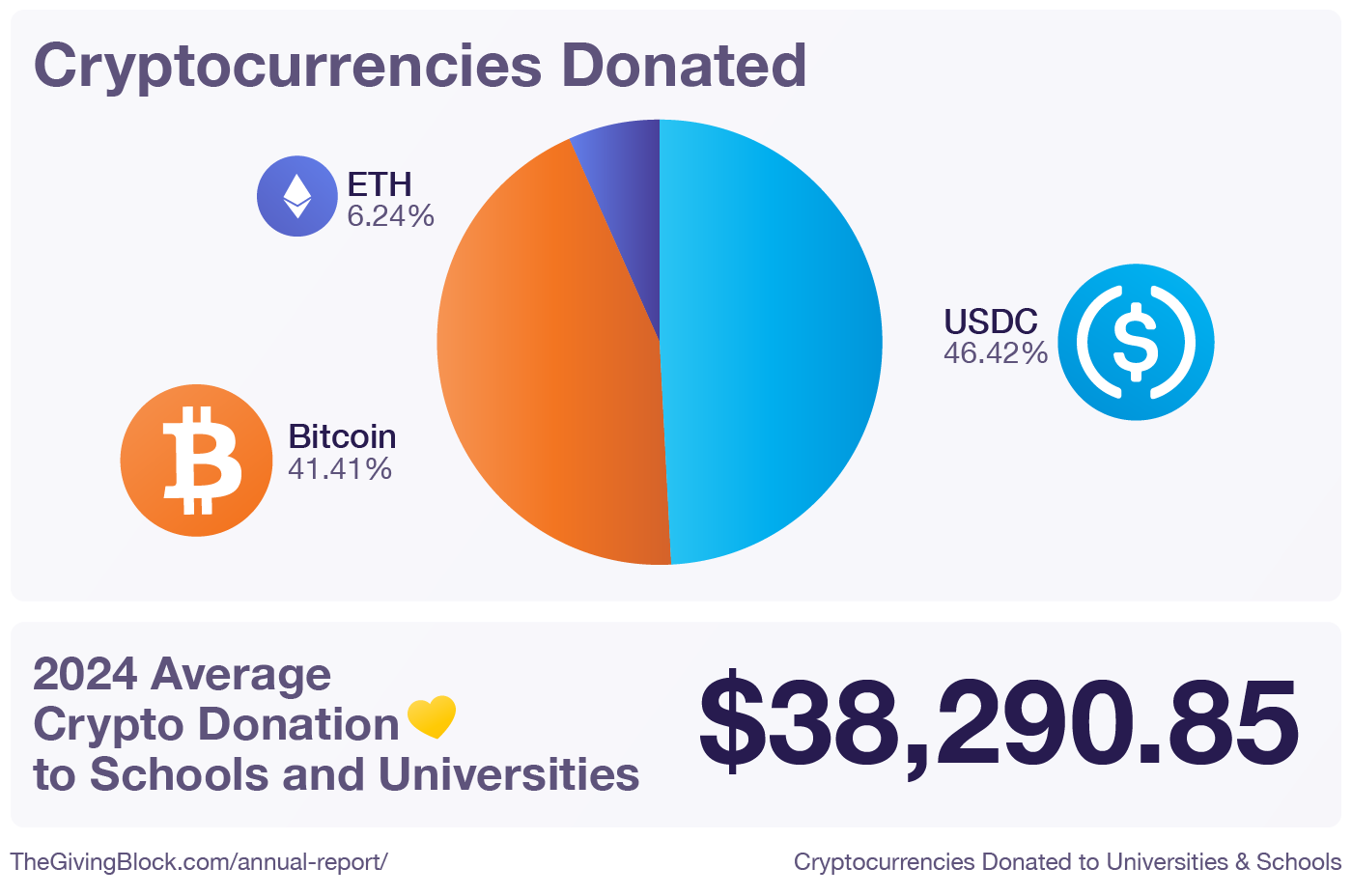
Faith Organizations
Faith-based organizations have a unique opportunity to leverage cryptocurrency to modernize giving methods while aligning with core values of generosity, transparency, and community support. Accepting crypto donations—including tithes and offerings—enables faith communities to expand their reach, connecting with donors across borders without the limitations of traditional banking systems. The transparency of blockchain technology also offers an added layer of accountability, allowing faith-based institutions to track and verify donations in real time.
Engage Young Donors
Engaging with crypto-native communities can help attract younger, tech-savvy supporters who are seeking mission-driven causes that align with their values. Crypto Philanthropy naturally aligns with various religious giving traditions: Christian organizations can position crypto as a seamless way to fulfill tithing commitments, Jewish communities can integrate it into Tzedakah practices, and Islamic charities can facilitate Zakat contributions with enhanced transparency and efficiency.
Expand Your Community & Reach
By integrating cryptocurrency donations, VIVE Church raised over $300,000, contributing significantly to their fundraising target for a new building and expanding their community reach.
2025 Forecast for Faith Organizations
Faith organizations that embrace cryptocurrency giving can engage the next generation of digital donors while streamlining contributions for mission work, disaster relief, and community development. Cryptocurrency’s borderless nature, speed, and transparency make it an ideal tool for faith-driven philanthropy, ensuring that contributions reach those in need with maximum efficiency. As digital giving continues to evolve, faith-based institutions that incorporate cryptocurrency into their fundraising strategies will be well-positioned to sustain long-term donor engagement and impact.
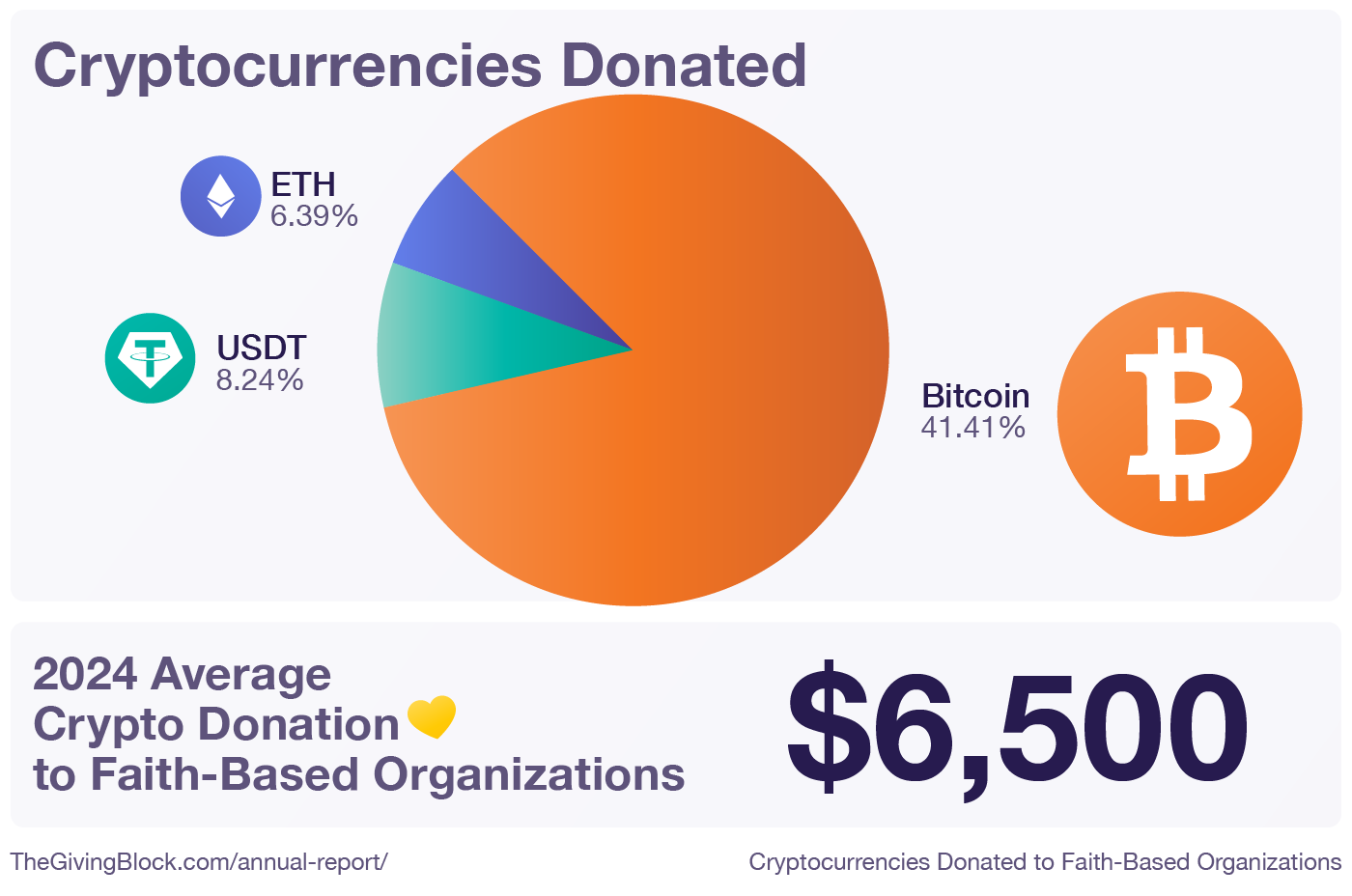
Foundations
Foundations are increasingly exploring cryptocurrency as part of a diversified philanthropic strategy, leveraging digital assets to enhance long-term impact.
Diversify Your Funding Opportunities
Holding a portion of crypto donations in reserve can provide financial flexibility and growth potential, particularly in bullish market conditions. The rise of decentralized giving models, including impact DAOs and blockchain-based grant funding, offers new opportunities for transparency and efficiency in philanthropic distribution. Partnering with Web3 initiatives can further align foundations with cutting-edge funding mechanisms, ensuring continued relevance in an evolving financial landscape. Additionally, donor-advised crypto funds (DACFs) are emerging as a powerful tool, allowing donors to contribute crypto assets toward causes they care about while optimizing tax benefits.
2025 Forecast for Foundations
As Crypto Philanthropy gains traction, foundations that adopt a forward-thinking approach to digital asset management will be better equipped to maximize their long-term impact. Diversifying endowment strategies with crypto holdings, leveraging blockchain technology for transparency, and collaborating with decentralized funding initiatives will position foundations at the forefront of modern philanthropy.
Strategic Recommendations for Crypto Donors
Cryptocurrency has emerged as a powerful tool for charitable giving, offering unique opportunities for donors to support their favorite causes. This guide provides essential recommendations for crypto donors, covering key aspects such as crypto selection, timing strategies, choosing the right nonprofit, and navigating the tax implications of cryptocurrency donations. By following these guidelines, donors can maximize the impact of their Crypto Philanthropy while ensuring a seamless and rewarding giving experience.
Disclaimer: This information is for educational and illustration purposes only, and is not legal or tax advice. Consult an attorney or tax advisor.
Crypto Selection: How to Choose Which Crypto to Donate
Selecting which cryptocurrency to donate is a crucial step in maximizing the impact of your charitable giving. Here are some key factors to consider when making your decision, including liquidity, tax benefits, and alignment with your values.
- Opt for high-liquidity assets like BTC and ETH for faster processing.
- Consider the most appreciated crypto assets in your portfolio to maximize the tax benefit associated with avoiding capital gains tax.
- Use stablecoins for precise donation amounts and lower volatility.
- Consider impact-driven tokens that align with your values.
Timing Strategies
Effectively timing your cryptocurrency donations can significantly enhance their impact and tax benefits. Consider the following approaches:
- DCA (Donation Cost Averaging): Spreading donations over time to mitigate volatility.
- End-of-Year Giving: Maximizing tax deductions before tax deadlines.
- “Give Don’t Sell” Approach: Donating directly from your crypto wallet to avoid capital gains taxes.
Choosing the Right Nonprofit
Choosing the right nonprofit is crucial to ensure your cryptocurrency donation has the greatest possible impact. It’s essential to verify that the nonprofit explicitly accepts cryptocurrency donations and tax benefits. Thoroughly investigate the nonprofit’s transparency and how they allocate funds. Finally, consider supporting smaller nonprofits where your donation may have a more direct and immediate impact.
Taxable Events: How to Avoid Taxable Events When Giving Crypto
Donating cryptocurrency directly to a qualified charity can help you avoid paying capital gains taxes on your crypto profits. This tax-saving strategy allows you to support your chosen causes while minimizing your tax burden.
- Donate Directly: Direct donations to nonprofits avoid capital gains tax liabilities.
- Use Donor-Advised Funds (DAFs): Cryptocurrency donations through DAFs allow tax-efficient giving.
- Stay Informed on Tax Laws: Keep updated with IRS guidelines on Crypto Philanthropy.
- Appraisals: Have any crypto donations over $5,000 in value appraised to meet IRS requirements.
- Reporting and Records: Ensure that you obtain the necessary paperwork (receipt, 8283 form, appraisal report) to secure your charitable deduction.
2035: What Crypto Means for The Future of Philanthropy
What’s Inside: This section explores how cryptocurrency will shape the future of philanthropy by 2035 in-part due to transfers of wealth and the adoption of new technologies.
Major Gift Donors Will Get Younger
The rise of cryptocurrency has democratized investment opportunities, enabling younger individuals to accumulate wealth earlier than previous generations. As of 2024, the blockchain market is valued at approximately $15.20 billion and is projected to grow to $776.47 billion by 2035, reflecting a compound annual growth rate (CAGR) of 42.98%. This rapid growth indicates a significant increase in wealth among younger investors, positioning them to become major donors earlier in their lives according to Roots Analysis.
Based on the projected growth of the blockchain market and maintaining the same ratio of donation to market cap, the estimated amount of crypto donations in 2035 would be approximately $89.27 billion. This estimate assumes that the relationship between crypto market cap and charitable giving remains consistent over time.
This trend aligns with the anticipated Great Wealth Transfer, where over $80 trillion is expected to change hands from older generations to younger ones. The combination of inherited wealth and early investment success in cryptocurrencies places this generation in a unique position to make substantial philanthropic contributions.
Blockchain Equals Transparency in Fundraising and Operations
Blockchain technology offers unparalleled transparency for nonprofits. By recording transactions on an immutable ledger, donors can trace their contributions in real-time, ensuring funds are utilized as intended. This level of transparency fosters trust and accountability, encouraging more substantial and frequent donations. Moreover, blockchain can streamline administrative processes, reducing overhead costs and allowing organizations to allocate more resources directly to their causes.
AI and Crypto: A Smarter Way to Give
Artificial Intelligence (AI) and blockchain technology are coming together in ways that could change how charities receive and manage donations. One of the biggest innovations is smart contracts—these are automated agreements on the blockchain that execute transactions when certain conditions are met, without needing a middleman.
In the future, AI-powered systems could help manage these smart contracts, making philanthropy more efficient. For example, an AI system could monitor global events, detect when disaster relief is needed, and automatically trigger donations from a fund. This would mean faster response times and fewer administrative hurdles for nonprofits.
While AI isn’t at the stage where it can fully manage finances or hold bank accounts, blockchain technology provides a foundation for AI-driven tools to play a bigger role in charitable giving. As AI and blockchain evolve, we can expect donation processes to become more transparent, efficient, and impactful according to a report released by Cornell University.










